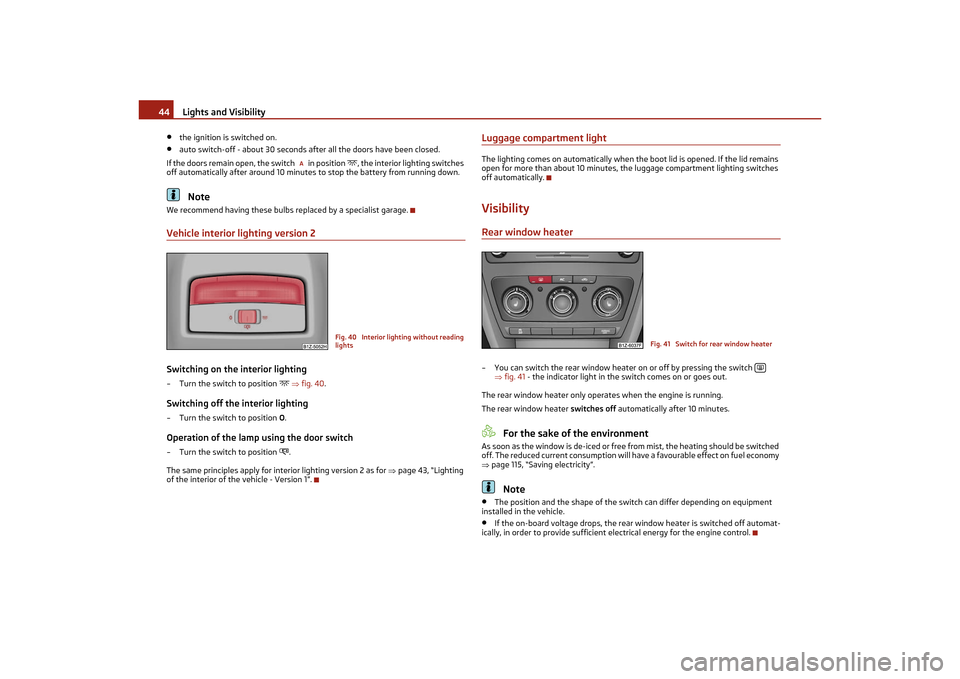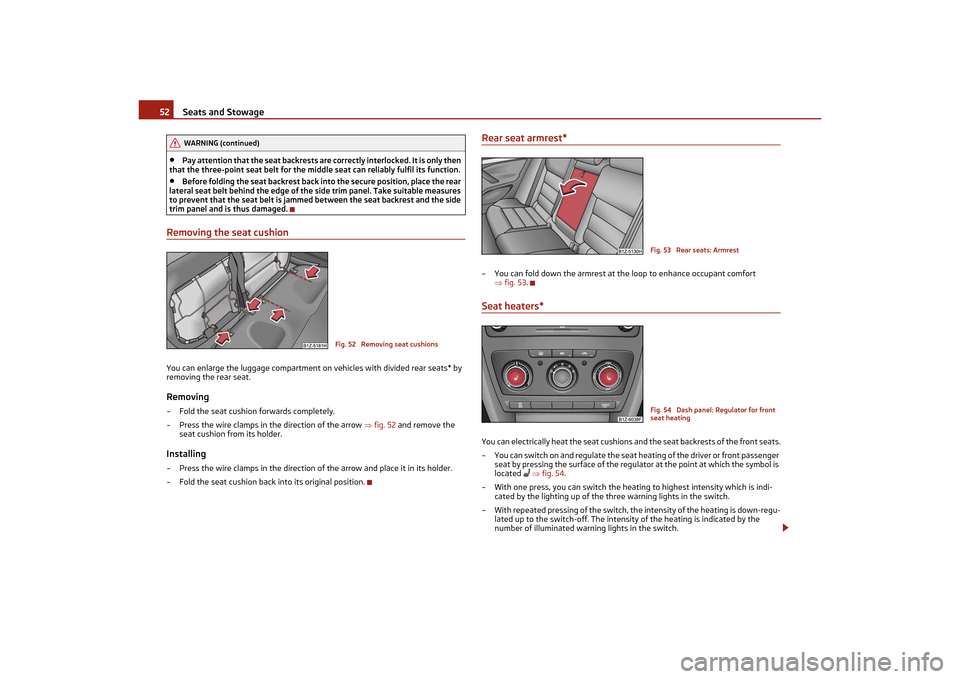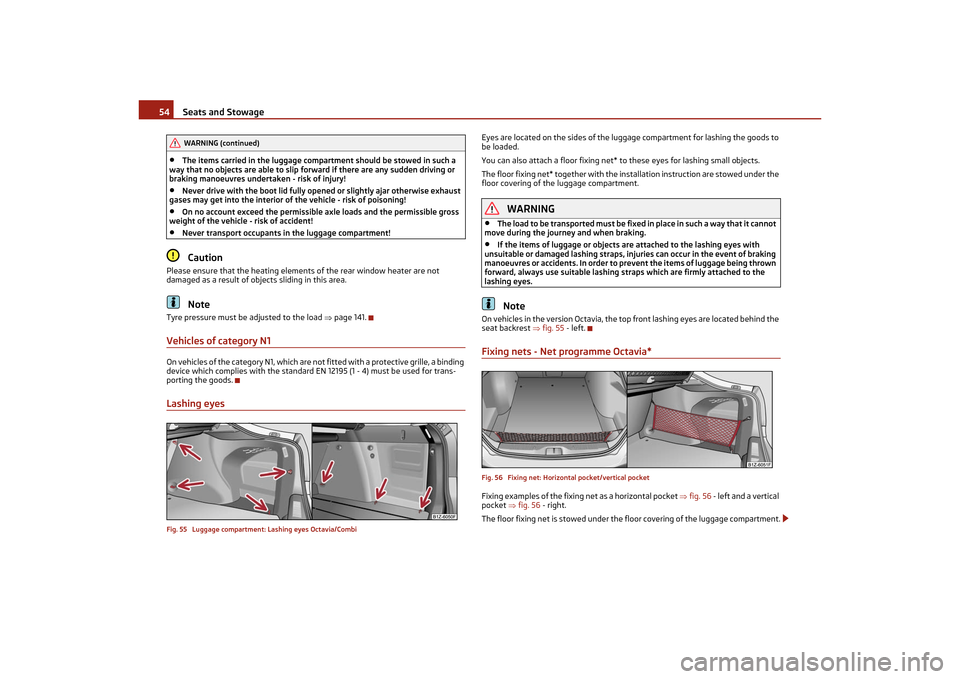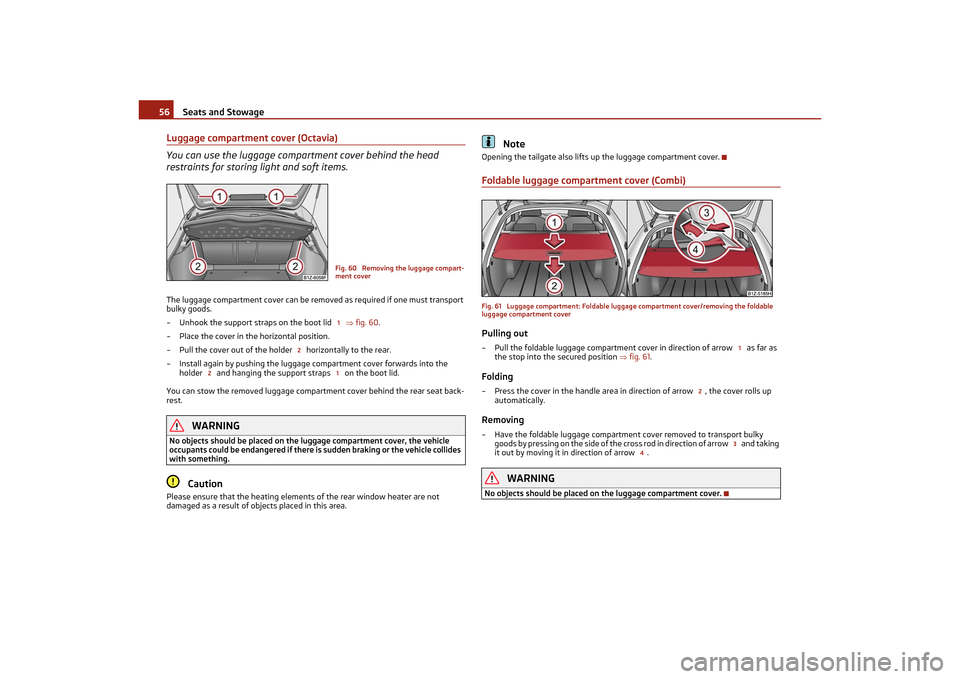2011 SKODA OCTAVIA TOUR heater
[x] Cancel search: heaterPage 45 of 183

Lights and Visibility
44
•
the ignition is switched on.
•
auto switch-off - about 30 seconds after all the doors have been closed.
If the doors remain open, the switch in position
, the interior lighting switches
off automatically after around 10 minutes to stop the battery from running down.
Note
We recommend having these bulbs replaced by a specialist garage.Vehicle interior lighting version 2Switching on the interior lighting– Turn the switch to position
fig. 40 .
Switching off the interior lighting– Turn the switch to position O.Operation of the lamp using the door switch– Turn the switch to position
.
The same principles apply for interior lighting version 2 as for page 43, “Lighting
of the interior of the vehicle - Version 1”.
Luggage compartment lightThe lighting comes on automatically when the boot lid is opened. If the lid remains
open for more than about 10 minutes, th e luggage compartment lighting switches
off automatically.VisibilityRear window heater– You can switch the rear window heater on or off by pressing the switch
fig. 41 - the indicator light in the switch comes on or goes out.
The rear window heater only operates when the engine is running.
The rear window heater switches off automatically after 10 minutes.
For the sake of the environment
As soon as the window is de-iced or free from mist, the heating should be switched
off. The reduced current consumption will ha ve a favourable effect on fuel economy
page 115, “Saving electricity”.
Note
•
The position and the shape of the switch can differ depending on equipment
installed in the vehicle.
•
If the on-board voltage drop s, the rear window heater is switched off automat-
ically, in order to provide sufficient electrical energy for the engine control.
A
Fig. 40 Interior lighting without reading
lights
Fig. 41 Switch for rear window heater
s2lk.2.book Page 44 Monday, April 18, 2011 7:41 AM
Page 49 of 183

Lights and Visibility
48
– With the other hand unlock the locking button in the direction of arrow and
remove the wiper blade.Attaching a wiper blade– Position the wiper blade onto the wiper arm and lock the locking button .
– Check whether the wiper blade is correctly attached.
The same remarks apply here as for page 47, “Replacing wiper blades for the
windscreen wipers”.Rear-view mirrorManual dimming interior rear-view mirrorBasic setting– Pull the lever on the bottom edge of the mirror forward.Dimming mirror– Pull the lever on the bottom edge of the mirror back.Exterior mirror
You can adjust the exterior mirrors electrically*.The exterior mirror heater only operates when the engine is running and up to an
outside temperature of +20 °C.
Heating of the external mirror – Turn the rotary knob to position
fig. 46 .
Adjusting left and right exterior mirrors simultaneously– Turn the rotary knob to position
. The movement of the mi rror surface is iden-
tical to the movement of the rotary knob.
Adjusting the right-hand exterior mirror– Turn the rotary knob to position
. The movement of the mirror surface is iden-
tical to the movement of the rotary knob.
Switching off operating control– Turn the rotary knob to position
.
WARNING
•
Convex (curved outward) or spherical (differently curved) exterior mirrors
increase the vision field. They do, howe ver, make objects appear smaller in the
mirror. These mirrors are only of limited use, therefore, for estimating distances
to the following vehicles.
•
Use whenever possible the interior rear mirror, for estimating the distances
to the following vehicles.Note
•
Do not touch the surfaces of the exterior mirrors if the exterior mirror heater is
switched on.
•
You can set the exterior mirrors by hand, if the power setting function fails at
any time by pressing on the edge of the mirror surface.
•
Contact your specialist garage if a faul t exists with the power setting of the
exterior mirrors.
A
A
Fig. 46 Inner part of door: Rotary knob
s2lk.2.book Page 48 Monday, April 18, 2011 7:41 AM
Page 53 of 183

Seats and Stowage
52
•
Pay attention that the seat backrests are correctly interlocked. It is only then
that the three-point seat belt for the midd le seat can reliably fulfil its function.
•
Before folding the seat backrest back into the secure position, place the rear
lateral seat belt behind the edge of the side trim panel. Take suitable measures
to prevent that the seat belt is jammed between the seat backrest and the side
trim panel and is thus damaged.
Removing the seat cushionYou can enlarge the luggage compartment on vehicles with divided rear seats* by
removing the rear seat.Removing– Fold the seat cushion forwards completely.
– Press the wire clamps in the direction of the arrow fig. 52 and remove the
seat cushion from its holder.Installing– Press the wire clamps in the direction of the arrow and place it in its holder.
– Fold the seat cushion back into its original position.
Rear seat armrest*– You can fold down the armrest at th e loop to enhance occupant comfort
fig. 53 .Seat heaters*You can electrically heat the seat cushions and the seat backrests of the front seats.
– You can switch on and regulate the seat heating of the driver or front passenger seat by pressing the surface of the regulator at the point at which the symbol is
located
fig. 54 .
– With one press, you can switch the heating to highest intensity which is indi- cated by the lighting up of the three warning lights in the switch.
– With repeated pressing of the switch, th e intensity of the heating is down-regu-
lated up to the switch-off. The intensit y of the heating is indicated by the
number of illuminated warning lights in the switch.
WARNING (continued)
Fig. 52 Removing seat cushions
Fig. 53 Rear seats: ArmrestFig. 54 Dash panel: Regulator for front
seat heating
s2lk.2.book Page 52 Monday, April 18, 2011 7:41 AM
Page 54 of 183

Seats and Stowage53
Using the system
Safety
Driving Tips
General Maintenance
Breakdown assistance
Technical Data
WARNING
If you or the passenger have a subdued pa in and/or temperature sensitivity, e.g.
through medication, paralysis or because of chronic illness (e.g. diabetes), we
recommend not to use the seat heating at al l. This can lead to burns on the back,
the posterior and the legs which are difficult to heal. If the seat heating is used,
we recommend to make regular breaks in your journey when driving long
distances, so that in specific cases as mentioned above the body can recuperate
from the stress of the journey. Please consult your doctor, who can evaluate
your specific condition.
Caution
•
You should not kneel on the seats or otherwise apply pressure at specific points
in order to avoid damaging the heating elements of the seat heaters.
•
Do not use the seat heating if the seats are not occupied by persons or if objects
are fastened or stored on them, for example a child seat, a bag etc. A fault of the
heating elements in the seat heating can occur.
•
Do not clean the seats moist page 125.Note
•
The seat heating should only be switched on when the engine is running. This
has a significant effect of saving on the battery capacity.
•
If the on-board voltage drops, the seat heating is switched off automatically, in
order to provide sufficient electrical energy for the engine control.
PedalsConcerning a secure depressing of the peda l, you should use only footmats from the
Škoda genuine accessories.
Operation of the pedals must not be hindered!
WARNING
•
Greater pedal distances may be needed when there is a fault in the brake
system.
•
Do not place any footmats or other additional floor coverings in the area of
the pedals in order to ensure that all the pedals can be fully depressed and are
able to return unobstructed to their initial position - risk of accident!
•
There must be no objects on the floor which could roll under the pedals. You
would then no longer be able to apply the brakes, operate the clutch or acceler-
ator - risk of accident!
luggage compartmentLoading the luggage compartmentPlease observe the following in the interest of having good handling characteristics
of your vehicle:
– Distribute the items of luggage as evenly as possible.
– Place heavy objects as far forward as possible.
– Attach the items of luggage to the lashing eyes or the fixing net* page 54.
In the event of an accident, there is such a high kinetic energy which is produced by
small and light objects that they can cause severe injuries. The magnitude of the
kinetic energy depends on the speed at which the vehicle is travelling and on the
weight of the object. The speed at which the vehicle is travelling is in this case the
more significant factor.
Example: In the event of a frontal collis ion at a speed of 50 km/h, an unsecured
object with a weight of 4.5 kg produces an energy, which corresponds to 20 times
its own weight. This means that it results in a weight of approx. 90 kg. You can
imagine the injuries that can occur, if this “bullet” is flying through the interior
compartment and hits an occupant.
WARNING
•
Stow the objects in the luggage compartment and attach them to the lashing
eyes.
•
Loose objects in the passenger compar tment can be thrown forward during
a sudden manoeuvre or in case of an ac cident and can injure the occupants or
other oncoming traffic. This risk is still increased, if the objects which are flying
around are hit by a deployed airbag. In this case, the objects which are thrown
back can injure th e occupants - hazard.
•
Please note that the handling properti es of your vehicle may be affected
when transporting heavy objects as a result of the displacement of the centre of
gravity. The speed and style of driv ing must be adjusted accordingly.WARNING (continued)
s2lk.2.book Page 53 Monday, April 18, 2011 7:41 AM
Page 55 of 183

Seats and Stowage
54
•
The items carried in the luggage compartment should be stowed in such a
way that no objects are able to slip fo rward if there are any sudden driving or
braking manoeuvres undert aken - risk of injury!
•
Never drive with the boot lid fully opened or slightly ajar otherwise exhaust
gases may get into the interior of the vehicle - risk of poisoning!
•
On no account exceed the permissible axle loads and the permissible gross
weight of the vehicle - risk of accident!
•
Never transport occupants in the luggage compartment!Caution
Please ensure that the heating elements of the rear window heater are not
damaged as a result of objects sliding in this area.
Note
Tyre pressure must be adjusted to the load page 141.Vehicles of category N1On vehicles of the category N1, which are no t fitted with a protective grille, a binding
device which complies with the standard EN 12195 (1 - 4) must be used for trans-
porting the goods.Lashing eyesFig. 55 Luggage compartment: Lashing eyes Octavia/Combi
Eyes are located on the sides of the lugg age compartment for lashing the goods to
be loaded.
You can also attach a floor fixing net* to these eyes for lashing small objects.
The floor fixing net* together with the in stallation instruction are stowed under the
floor covering of the luggage compartment.
WARNING
•
The load to be transported must be fixe d in place in such a way that it cannot
move during the jour ney and when braking.
•
If the items of luggage or objects ar e attached to the lashing eyes with
unsuitable or damaged lashing straps, injuries can occur in the event of braking
manoeuvres or accidents. In order to pr event the items of luggage being thrown
forward, always use suitable lashing st raps which are firmly attached to the
lashing eyes.Note
On vehicles in the version Octavia, the to p front lashing eyes are located behind the
seat backrest fig. 55 - left.Fixing nets - Net programme Octavia*Fig. 56 Fixing net: Horizontal pocket/vertical pocketFixing examples of the fixing net as a horizontal pocket fig. 56 - left and a vertical
pocket fig. 56 - right.
The floor fixing net is stowed under the floor covering of the luggage compartment.
WARNING (continued)
s2lk.2.book Page 54 Monday, April 18, 2011 7:41 AM
Page 57 of 183

Seats and Stowage
56
Luggage compartment cover (Octavia)
You can use the luggage compartment cover behind the head
restraints for storing light and soft items.The luggage compartment cover can be removed as required if one must transport
bulky goods.
– Unhook the support straps on the boot lid fig. 60 .
– Place the cover in the horizontal position.
– Pull the cover out of the holder horizontally to the rear.
– Install again by pushing the luggage compartment cover forwards into the
holder and hanging the suppor t straps on the boot lid.
You can stow the removed luggage compartment cover behind the rear seat back-
rest.
WARNING
No objects should be placed on the luggage compartment cover, the vehicle
occupants could be endangered if there is sudden braking or the vehicle collides
with something.
Caution
Please ensure that the heating elements of the rear window heater are not
damaged as a result of objects placed in this area.
Note
Opening the tailgate also lifts up the luggage compartment cover.Foldable luggage compartment cover (Combi)Fig. 61 Luggage compartment: Foldable lugg age compartment cover/removing the foldable
luggage compartment coverPulling out– Pull the foldable luggage compartment cover in direction of arrow as far as the stop into the secured position fig. 61 .Folding– Press the cover in the handle area in direction of arrow , the cover rolls up
automatically.Removing– Have the foldable luggage compartment cover removed to transport bulky
goods by pressing on the side of the cros s rod in direction of arrow and taking
it out by moving it in direction of arrow .
WARNING
No objects should be placed on the luggage compartment cover.
Fig. 60 Removing the luggage compart-
ment cover1
2
2
1
1
2
3
4
s2lk.2.book Page 56 Monday, April 18, 2011 7:41 AM
Page 68 of 183

Heating and air conditioning system67
Using the system
Safety
Driving Tips
General Maintenance
Breakdown assistance
Technical Data
HeatingUsing the system
The heating system delivers air into the interior of the vehicle and
warms it as required.Fig. 81 Heating: Control elementsSetting temperature– Turn the control dial fig. 81 to the right in order to increase the tempera-
ture.
– Turn the control dial to the left in order to increase the temperature.Controlling blower– Turn the blower switch into one of the po si ti o ns , 1 to 4, in o rd e r t o sw itc h the
blower on.
– Turn the blower switch into position 0 in order to switch the blower off.
– If you wish to shut off the fresh air su pply, use the button - recirculated air
mode .Control for air distribution– You can adjust the direction of the air flow using the air distribution control
page 66.
Rear window heater– Press button . Further information page 44, “Rear window heater”.
The air inlet in front of the windscreen must be free of ice, snow or leaves in order
to ensure that the heating and ve ntilation systems operate properly.
The heating effect depends on the coolan t temperature. The full heating effect
does not kick in until the engine is run in.
The blower should aways be on to prevent the windows from misting up.
WARNING
You should not leave recirculated air mode on over a longer period of time, as
“stale” air may result in fatigue in the dr iver and occupants, divert your attention
and also cause the windows to mist up. Th e risk of having an accident increases.
Switch recirculated air mode off as soon as the windows begin misting up.
Note
•
The whole heat output will be needed to unfrost the windscreen and side
windows. No warm air will be fed to the footwell. This can lead to restriction of the
heating comfort.
•
The used air streams out through the air removal openings in the luggage
compartment.
AABB
1
C
2
s2lk.2.book Page 67 Monday, April 18, 2011 7:41 AM
Page 71 of 183

Heating and air conditioning system
70
which can only be eliminated through considerable effort and expense (replace-
ment of compressor).Using the systemFig. 82 Climatic: Control elementsSetting temperature– Turn the control dial fig. 82 to the right in order to increase the tempera-
ture.
– Turn the control dial to the left in order to increase the temperature.Controlling blower– Turn the blower switch into one of the po si ti o ns , 1 to 4, in o rd e r t o sw it ch the
blower on.
– Turn the blower switch into position 0 in order to switch the blower off.
– If you wish to shut off the fresh air supply, use the button - recirculated air mode page 72.Control for air distribution– You can adjust the direction of the air flow using the air distribution control
page 66.switching cooling on and off– Press the button fig. 82 . The warning light lights up in the button. – When you again press the switch , the cooling system is switched off. The
warning light in the button goes out.
Rear window heater– Press button . Further information page 44, “Rear window heater”.
Note
•
The whole heat output will be needed to unfrost the windscreen and side
windows. No warm air will be fed to the footwell. This can lead to restriction of the
heating comfort.
•
The used air streams out through the air removal openings in the luggage
compartment.
•
If the cooling system has not been switched on for a lengthy period, odours may
be produced at the evaporator because of deposits. Switch the cooling system on
at least once a month for approximately 5 minutes at the highest blower stage -
also during the cold season of the year - in order to remove such odours. Also open
a window for a short time.
•
Please refer to the information regarding recirculated air mode page 72.
AABB
3
C
AC
2
AC
1
s2lk.2.book Page 70 Monday, April 18, 2011 7:41 AM